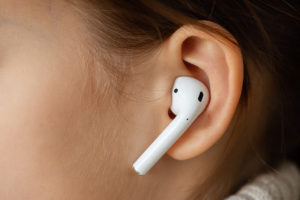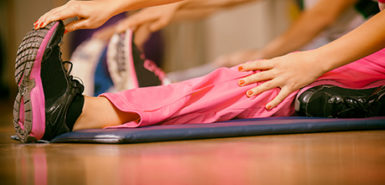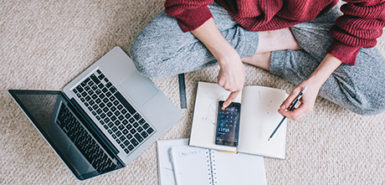
Podcasts. Music. Audiobooks. Movies. Gaming. Talking with friends and family.
There are a lot of reasons for popping in your earbuds or putting on your headphones.
But ear doctors send a warning to young people and adults alike: All that listening might be fun and convenient, but it can damage your hearing.
“We are definitely seeing more noise-induced hearing loss over the years than we would expect,” said Chad Afman, MD, a pediatric otolaryngologist with Corewell Health Medical Group Ear Nose & Throat.
For a long time—after the government set strict parameters to help prevent hearing loss in workplaces such as factories—there was a downward trend in hearing loss.
“Now we’re starting to see an increase again, and it’s not due to work or military exposure as much as people not taking care of their ears on their own time,” Dr. Afman said.
That includes all that techy personal listening gear everyone loves.
It’s not just loud volume that’s posing a risk, but also listening at a comfortable volume for many hours, Dr. Afman warned.
According to the American Academy of Otolaryngology – Head and Neck Surgery, about 10 million Americans have irreversible noise-induced hearing loss. Up to 17 percent of teens ages 12-19 have symptoms that suggest hearing loss in one or both ears.
With some awareness and simple precautions, you can enjoy your music and preserve your hearing.
Keep the volume down
Listening to music at volumes higher than 85 decibels for long periods of time can cause permanent hearing loss. The average portable music player is played at 100 decibels, and cell phones can produce a maximum of 115 decibels.
Dr. Afman said a simple lesson in decibel levels is surprising to many. An increase from 85 to 88 decibels is not just a linear three-unit increase. It’s actually three times as loud.
So, if 60 decibels is a normal, conversational volume, and you have you music playing at 70 decibels in your earbuds, that’s 10 times louder.
“Even those little changes can make a big difference,” Dr. Afman said.
He often asks patients: After a loud concert or listening to loud music in your earbuds, have you ever had a feeling of fullness or ringing in your ear?
“That’s a sign that you have caused trauma to your cochlea,” he said. “Once that happens, there’s no way to tell if it’s going to be temporary or permanent.”
And over time, that damage could result in needing hearing aids in later years.
Limit earbud time
Even at a comfortable level, listening through personal listening devices for long periods of time can damage hearing, Dr. Afman said.
He suggests following the 60/60 rule: Listen at 60 percent volume for 60 minutes, then take a break for 30 minutes or more to allow your ears to rest and recover.
Also, ears need to breathe, he said.
Earbuds can create infections in the outer ear canal—commonly called swimmer’s ear—because they trap moisture. This is especially a problem when sweating while exercising, he said.
Earbuds can cause an 11-fold increase in bacteria in the ear canal. This is also the reason you shouldn’t share earbuds with anyone, and why you should clean your earbuds once a week.
Dampen—don’t soak—a cotton ball with rubbing alcohol and clean off any buildup on the earbuds. Then store them in a clean, dry case.
Choose ear gear wisely
Earbuds can be up to 9 decibels louder than headphones.
When he’s in an environment with a lot of background noise, like an airplane, Dr. Afman said he uses noise-canceling headphones. Then he can adjust the volume to a lower level and still hear what’s he’s listening to.
When he’s running, however, he wears bone conduction headphones, which transmit sound through vibrations on the bones of the head and jaw. This way he can still hear what’s happening around him for safety.
He recommends never wearing anything in or over the ear when running or cycling in traffic—and certainly not when driving.
“That’s a big no-no,” Dr. Afman said. “You’re not going to hear cars honking as well and you’re not going to hear those surrounding auditory cues.”
Be mindful
You look around and everyone has earbuds or headphones on.
The message: Don’t talk to me.
“If you’re always wearing your personal listening device, it’s socially isolating for yourself and others,” Dr. Afman said.
Take them off and tune in to the people around you now and again, he said.
There is one plus to a society with many people having devices in their ears, Dr. Afman said.
“It has socially normalized having something in your ear, which is a huge win as far as needing hearing aides,” he said. “It’s really changed the tide as far as people being embarrassed about wearing hearing aides. I can now get grade-schoolers excited about wearing them.”
 /a>
/a>
 /a>
/a>
 /a>
/a>